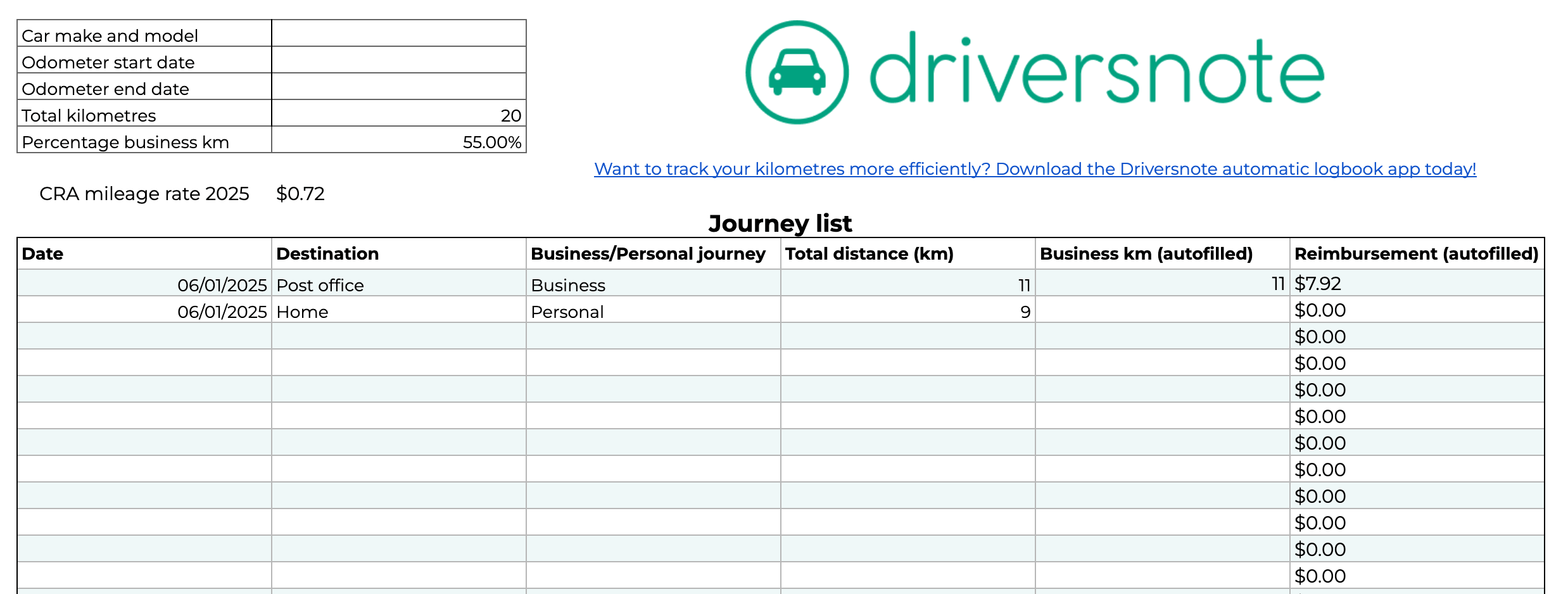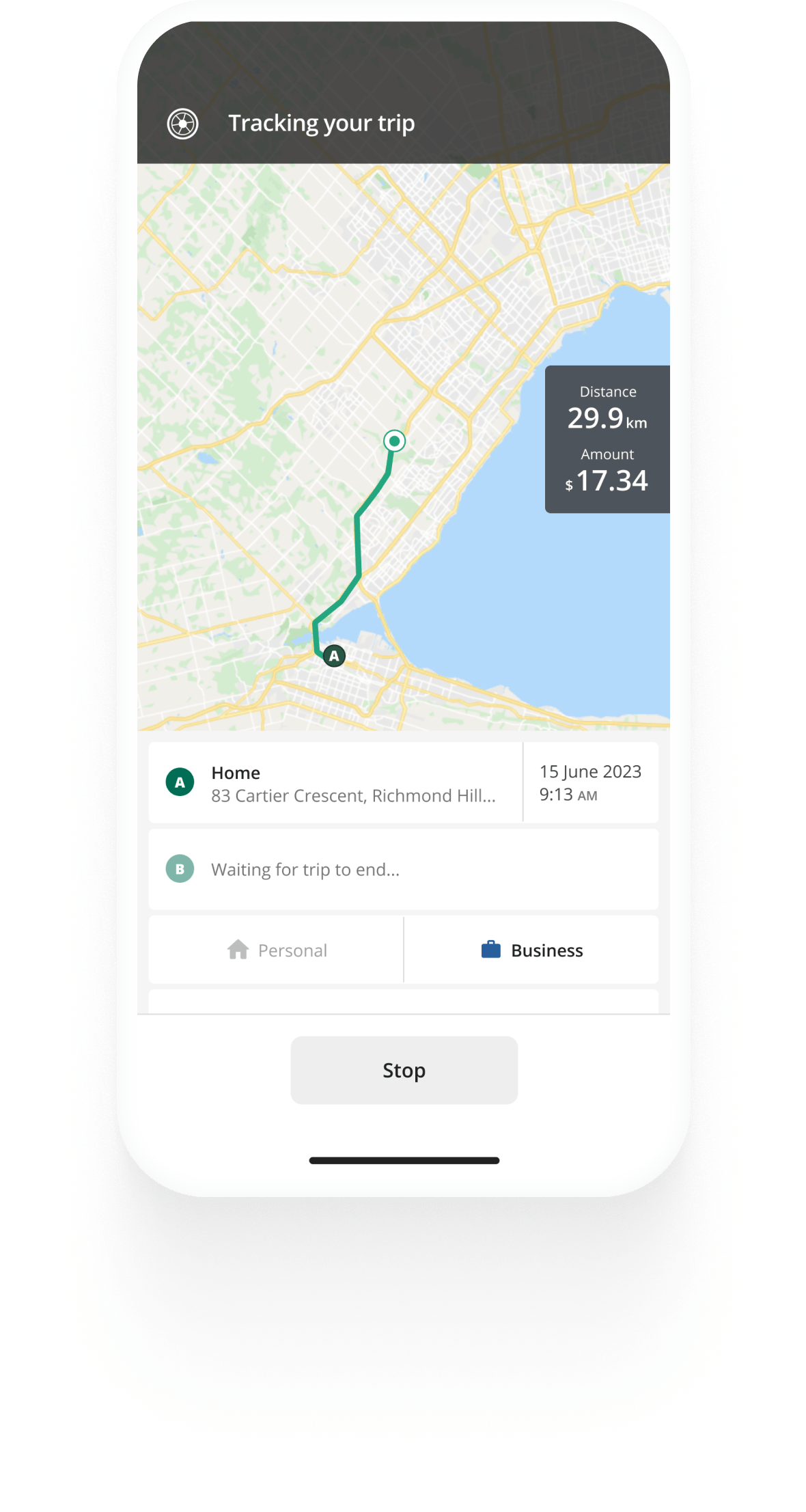Track mileage automatically
Get started.svg)
Free Mileage Log Template - Excel, Sheets & PDF Log Book
In this article
- Download the mileage log template - PDF, Excel, Sheets
- What you need to log in the mileage log book template
- Using the mileage log book template as a self-employed individual
- Using the mileage log book template as an employee
- Using the mileage log template to calculate your reimbursement
- Mileage logging for businesses
- For how long you should keep your mileage logbook
- Using the mileage log template in Excel or PDF
- Using an automatic mileage tracker
- Download the mileage log template - PDF, Excel, Sheets
- What you need to log in the mileage log book template
- Using the mileage log book template as a self-employed individual
- Using the mileage log book template as an employee
- Using the mileage log template to calculate your reimbursement
- Mileage logging for businesses
- For how long you should keep your mileage logbook
- Using the mileage log template in Excel or PDF
- Using an automatic mileage tracker
To claim mileage deductions as self-employed or to receive mileage reimbursements from your employer, you must maintain proper records—preferably some that comply with CRA requirements.
But you don't have to buy a book or even spend time creating a spreadsheet yourself - we've got you covered with an easy-to-use template that already includes the formula you need to calculate your deductions or reimbursements based on the CRA mileage rates for 2025.
Download the mileage log template - PDF, Excel, Sheets

Use the buttons above to download the free Driversnote Template as an Excel, Sheet or printable PDF.
The Excel and Sheets versions include a mileage log example to help you visualize what is required when filling out a mileage log. Simply use the other Sheets tab to get an empty version, which you can use to log your own trips.
If you use the free Excel or Sheets mileage template, a formula has already been set up to calculate your reimbursement based on the CRA mileage rates 2025 for the first 5000 km.
If you use the printable PDF version, you must do all calculations manually.
Alternatively, you can try the Driversnote mileage tracker app for even quicker mileage logging, which is recommended by accountants in Canada.


Track business driving with ease
Trusted by millions of drivers
Automate your logbook Automate your logbook

Automatic mileage tracking and CRA-compliant reporting.
Get started for free Get started for freeWhat you need to log in the mileage log book template
According to the CRA, you need to keep a precise logbook to document the use of a vehicle for business activities. The logbook should thoroughly record each business trip, including the following information:
- Date of the trip: The exact date when the journey occurred.
- Destination: The final location or address where the trip ended.
- Purpose of the trip: A concise explanation of the reason for the journey, such as meeting a client, delivering products, or attending a business function.
- Number of kilometers driven: The total distance covered during the trip.
You also need to note the odometer readings at the start and end of each fiscal period. If you change vehicles throughout the year, document the dates of these changes along with the odometer readings at the time of purchase, sale, or trade.
Personal vs. Business Use
For those who utilize their personal vehicle for business purposes, the CRA permits deductions solely for the business-related portion of expenses. This requires a clear differentiation between personal and business trips. By keeping a detailed logbook, you can accurately assess the percentage of business-related vehicle use, ensuring that only the business expenses are claimed.
Employees Receiving Allowances or Reimbursements
If you are an employee receiving an allowance or reimbursement from your employer for using your personal vehicle for work, it is essential to document and categorize your trips meticulously. Only the business-related portion of these allowances or reimbursements is considered tax-exempt. Proper documentation is vital to uphold the tax-exempt status of these amounts and to comply with CRA regulations.
Using the mileage log book template as a self-employed individual
You can deduct the actual car expenses incurred while conducting business as a self-employed individual. If you use your car solely for work, you can deduct all of the expenses associated with it.
If you use your vehicle for both business and personal trips, you can only deduct expenses corresponding to the percentage of business use of the vehicle. You need to keep a log of both personal and business trips to calculate the percentage of business use.
You won't need to use the amounts calculated in the template; the business trip percentage will suffice to calculate the percentage of actual expenses you can deduct.
According to the CRA, you can deduct the operating and maintenance expenses of your vehicle only if they are reasonable. Such expenses include:
- Licence & registration costs
- Fuel & oil
- Electricity (for zero-emission vehicles)
- Insurance
- Maintenance & repairs
- Leasing costs
- Interest on money borrowed to buy the motor vehicle
Remember that you must also keep separate logbooks for separate vehicles if you drive more than one vehicle for business. You can easily copy the mileage log template from this article to record mileage for different vehicles.
Learn more about mileage logging and deductions for self-employed.
Using the mileage log book template as an employee
If you are an employee, remember that aside from the standard requirements mentioned above, you may need to keep track of additional information if your employer requests.
If you use your own car for work-related activities, you can usually get reimbursement or claim tax deductions for your car expenses. The following are examples of business travel:
- Attending meetings or conferences outside of your typical working environment
- Getting supplies or delivering packages
- Getting from one place to another (for example, a client's office or worksite) while commuting.
- In most cases, mileage reimbursement is unavailable for travel from home to work.
Read more about mileage reimbursement for employees.
Using the mileage log template to calculate your reimbursement
The mileage log book template in Excel and Sheets format is set to calculate your reimbursement automatically since the formula is already there.
This sheet uses the CRA standard automobile allowance for the first 5000 km driven.
The rate for 2025 is $0.72 for the first 5000km driven and $0.66 for each km after that.
Example: You keep track of your mileage for January 2025, and you've driven 175 kilometres for business. Your employer reimburses you at 72 cents per kilometre - the CRA mileage rate for 2025. To figure out how much you'll get reimbursed, multiply the number of kilometres by the rate:
[km] * [rate], or 175 km * $0.72 = $126
Mileage logging for businesses
Try Driversnote for Teams if you need a solution for your whole team. Using the mileage log template above may be enough for your team to report their mileage, but our app can save a lot of time for you and your employees with the following features:
- Receive accurate and consistent mileage reports from your team.
- Approve or reject mileage reports in seconds.
- Invite and remove users and assign roles on the go.
- Driversnote will track employees’ mileage automatically, saving them the time they’d use to do so manually.
For how long you should keep your mileage logbook
The CRA requires you to preserve your records for six years from the day you file your tax return, whether you are an individual taxpayer or self-employed, in case they need to verify your claims.
Self-employed records
If you are self-employed, you must keep the "base year" logbook for six years from the end of the most recent tax year that was used as a base year if you adopt the simplified logbook technique. If your base year was recorded in 2018 and you utilized it to establish commercial usage in 2020, you must preserve the base year logbook record until at least 2026.
Employee records
As an employee, you may be requested to verify your expenses sometime in the future (which may include mileage for various reasons). It's a good idea to keep duplicates of documentation you’ve previously submitted to your employer because this can happen via no mistake of your own.
Company records
Companies must also maintain mileage records for a minimum of six years. This applies even if multiple vehicles are used for business purposes. It is essential to keep distinct records for each vehicle, detailing the total and business kilometres driven and the expenses associated with operating and maintaining each vehicle. Costs for each vehicle should be calculated individually. Learn about mileage reimbursements and allowances for employers.
Using the mileage log template in Excel or PDF
One of the easiest ways to log your mileage is to use the Excel or Sheets template. You can fill them out on your computer, but they may not be so convenient on your mobile device.
Pros: Using a mileage log template gives you full control. It allows you to add information manually and choose what to include. It is a helpful method for getting a general idea of how much you drive.
Cons: You may be prone to make mistakes since it is hard to remember every detail of a day’s worth of driving. You need to be extra careful since you will want to report your mileage as accurately as possible to the CRA or your employer. Keeping a PDF or Excel logbook involves manual work and may be time-consuming.
Using an automatic mileage tracker
By using a mileage tracking app, you get a detailed record of all your trips, which you can export as a PDF or Excel file and pass over to your manager or accountant. The report includes all the information necessary for the CRA and is ready to be utilized as proof for reimbursement claims or tax deductions. The best part is that you don’t have to do any calculations since the app does all your mileage calculations automatically.
Driversnote can track your trips automatically, which is perfect for those who sometimes forget to log their trips. With the app, you will always have your mileage reports as they are safely stored online. If you decide to use this template, always create a backup logbook if you lose your main one.

Tired of logging mileage by hand?
Effortless. CRA-compliant. Liberating.
Latest posts
- Company Cars: What Employers Need to Know About the Automobile Taxable Benefit
- Taxable Employee Benefits in Canada
- FAQ About The CRA Automobile Allowance
Related posts
Find The Best Mileage Tracking Apps For iPhone and Android
January 2, 2025 - 5 min read
You can save a lot of money by maximizing your tax deductions. The easiest way to do that is by having a reliable mileage tracking app...
How To Keep a CRA Compliant Mileage Log
September 28, 2022 - 5 min read
Are you keeping a mileage logbook if you're self-employed and use your vehicle for business purposes? If not...
Gig Drivers' Guide
March 7, 2025 - 5 min read
With the popularity of gig work you may be wondering if it’s worth it. Between ridesharing and delivery, see which side hustle is for you.


